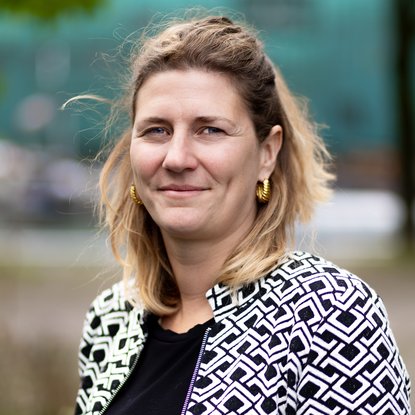Use of extended reality (XR) technology in Smart Urban Mobility
The presence and use of technologies, like extended reality (XR), that can provide us with a realistic experience of the world around us has increased dramatically in recent years. They have a lot of promise for entertainment, education, and socialization in the future. Because the technology provides real-world experience, it may be used to build experimental scenarios for testing various ideas and solutions before they are adopted in the "real-world."
The use of these technologies in urban mobility offers a wide range of possibilities, such as, simulations of interactions between traffic participants, usage and experience of mobility hubs or experiencing of a virtual city without cars.
The following blog post discusses the main features and differences of XR technologies and the use of the technology within the Smart Urban Mobility (SUM) team at AMS Institute.
The world of extended reality
There are 3 types of extended reality: Augmented Reality (AR), Virtual Reality (VR) an Mixed Reality (MR):
Augmented reality (AR) is adding digital layers to reality by using a device, a smartphone, or a special AR glasses. With AR you can virtually add visual information to a physical space and enhance user's real-world experience.
Virtual reality (VR) in contrast to AR, VR creates a completely computer-generated simulation. It’s a digital representation of the real environment. The virtual environment can range from very abstract to ultra-realistic. It can be experienced using a headset to generate realistic visuals and sounds. This experience happens in a virtual world. But still, users are able to move in a physical space which adds more emphasis on the "realism" of these simulations.
Mixed reality (MR) is the most recent advancement in XR which is a hybrid of the two worlds - a virtual and the real one. The projections of information are made in a similar way to AR, while the users can interact with physical elements in the real environment.
Reading time: 7 min
VR experiment at AMS Institute
Within the SIPCAT(1) project a VR experiment has been conducted at AMS Institute.
The main research question focuses on how automated vehicles (AVs), pedestrians and cyclists will interact and communicate between each other. The use of VR technology is the main tool for empirical findings. The specific objective of the project is to find out how to design, apply and assess a virtual reality experimental method for this purpose.
The applied Virtual Reality environment is a 'Digital Twin'(2) of the Marineterrein Amsterdam. Within this VR environment, participants are asked to cross a road and interact with an approaching automated vehicle. Since the experiment is happening in the VR, participants are using headsets that are projecting elements of the virtual world. They can control their position by moving through the room. This is tracked and recorded. There are multiple scenarios, in which position of user(s) and AV vary. The information of users and AVs reactions are collected in this interactive and reciprocal setting to get scientific conclusions on the participants behavior.
1: Safe interaction of pedestrians and cyclists with automated transport
2: digital twin is a virtual model designed to accurately reflect a physical object/environment
VR Technology: VR headset “HTC Vive” used in the SIPCAT experiment for immersive virtual settings
Benefits from a virtual setting
It's useful to know what can be expected in real life, e.g. when talking about automated vehicles. Virtual reality opens up new possibilities that were previously unthinkable. As an example, alternatives to eye contact between road users are being researched. There is a difference when you deal with an automated vehicle compared to a usual situation of the traffic setting of today. How can I tell if the vehicle has seen me? How can I know what the response of the vehicle will be and be certain that the AV will stop in front of me?
The insights gained from a setting in the Virtual Reality are very useful for next step within designing, implementing AV in the real-life setting.
Tom’s view on the testing possibilities with XR
In an interview with Marineterrein(3), Tom, Programme Developer at the Smart Urban Mobility team, says that the work in this digital twin is an excellent example of how the virtual environment can add value to gain new insights, as an addition to experiments and pilots in the real world. The benefit is that interactions and testing are risk-free.
3: Marineterrain: marineterrein.nl/news/vr-experiment-onderzoekt-interactie-tussen-zelfrijdend-vervoer-en-mensen/
“The possibilities are endless, not only in terms of autonomous transportation or mobility, for example in experimenting with other projects such as drones or Roboats, but also in the different domains AMS Institute is working on.”
Tom Kuipers
Program Developer
Maike’s experience as a user
Maike, Programme Developer at SUM took part in the experiment as a participant
“I am very much interested in this technology, as I believe it can give a lot of insights in human behavior. Especially when new technology is implemented into the real world.
As a participant it was interesting to join the experiment. Although I knew I was not in a real life setting and in a room with VR glasses on, i totally forgot this when joining the experiment and crossing the road in front of the Automated Vehicle. Also, the interaction with the other participants in the same experiment, who I saw via my VR glasses, felt as it was in a ‘normal’ situation.”
“I believe VR can and will be very powerful in designing and understanding for new mobility solutions in the future.”
Maike Simmes
Institute Manager
Petar’s experience in conducting the experiment
Petar, Programme Intern from the SUM team, took part in conducting the experiment as an assistant.
“I gained a lot of insights of the methodology and was engaged in interaction with participants and the technology itself. Sometimes connection problems and various issues occurred, that made the whole procedure longer. It is important to make user’s experience as close as possible."
“Most of the participants found the VR technology and the experience were entertaining and have enjoyed being part of it, which is very valuable for further experiments.”
Petar Koljensic
Former Intern Smart Urban Mobility at AMS Institute

Examples of XR in urban mobility planning worldwide
The use of XR technology in mobility planning is already widespread. Some projects offer interactive planning of traffic infrastructure, while others use participative planning in a process with stakeholders for smart street design. AR technologies has been used for adding digital information for participants in traffic. Various labs are founded for research on use of the XR technology regarding various aspects of mobility. Traffic safety is for some of them, like in the SIPCAT experiment, the main topic. Rapid development of Metaverse – an integrated network of 3D virtual worlds can accelerate use and popularity of this technology, especially in the sphere of digital communication.
VR as design tool for urban environments
The “City Intelligence Lab”(4) in Vienna developed by AIT (Austrian Institute of Technology) is an example which uses extended reality technology in finding solutions for urban environments. In this specific case, users can design and analyze one large urban development area and see the effects on climate, economic and mobility factors, that are projected as digital layer in the real environment. All of this is possible thanks to the usage of AR glasses that display virtual information on a real neighborhood model.
AR in Urban Planning: Planners can with explore new forms and developments in urban planning and design through the use of AR. (Source: Unsplash)
AR glasses for traffic information
Gregory Curtin(5) from Civic Resource Group proposes solutions in use of AR in improving of urban mobility transport, such as use of special device glasses, which would provide valuable real-time information of the traffic flows and congestion, directions of availability of parking spots without the distraction of looking away from the road.
4: CIL (City Intelligence Lab) develops new approaches and techniques for urban development practice: cities.ait.ac.at/site/
5: Augmented reality to improve urban mobility: realar-vr.cioreview.com/cxoinsight/augmented-reality-to-improve-urban-mobility-nid-14344-cid-135.html
Automotive Navigation: Head-up display solution using AR technology, that shares real-time information to the driver. (Source: Adobe Stock)
Wrapping up
After understanding the technologies and seeing some of the examples, the potential, problems, and risks are summarized. The question is how we can implement them and make the most of them, because it appears that the application and availability of these technological devices will only increase in the future.
Some of the takeaways from the experiment:
+ XR provides a secure experimental environment in which products can be tested before being implemented in the real world.
+ The experience demonstrates that the technology still has issues during implementation, making the experiment process longer and more challenging.
+ The question is whether the extended reality accurately matches the real world, and whether the experiment participants' decisions and answers mirror their regular behavior. It's crucial to make the experiment's settings pleasant for the user.
+ The entertaining nature of XR technologies helps to attract participants in the experiments and enhances its scientific value.
Find more about SUM and our contact details on: https://www.ams-institute.org/urban-challenges/smart-urban-mobility/



